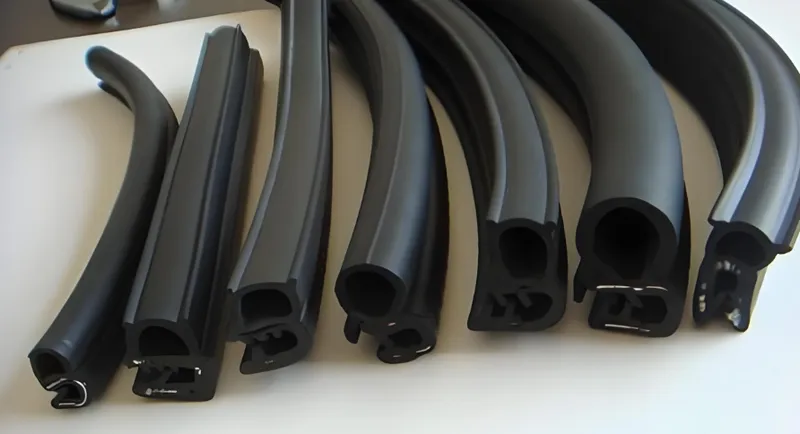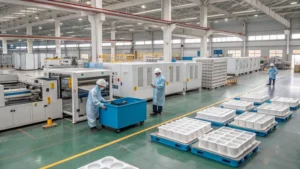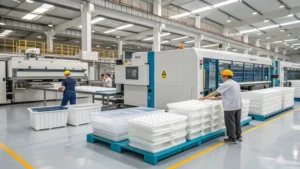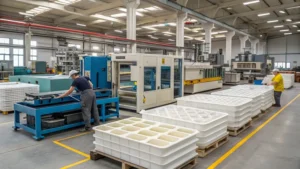
Plastic extrusion is a cornerstone of modern manufacturing, transforming raw plastic into a wide array of products, from pipes and sheets to automotive parts and medical devices. This process involves melting plastic and shaping it through a die to create continuous profiles. However, even with a well-controlled process, defects can occur, compromising the quality and functionality of the final product. Identifying and addressing these defects is crucial for manufacturers to maintain high standards and meet industry requirements.
The most common defects in plastic extrusions1 include die swell, warping, surface roughness, color variation, contamination, inconsistent dimensions, bubbles or voids, shrinkage, melt fracture, and die lines. These defects can be spotted through visual inspection, dimensional measurements, or advanced testing methods like X-ray or ultrasonic testing.
In this blog post, we’ll explore these defects in detail, how to identify them, and the steps manufacturers can take to prevent or mitigate them. Whether you’re new to plastic extrusion or looking to refine your quality control processes2, this guide will help you understand and tackle the challenges of extrusion defects.
Defects in plastic extrusions can significantly impact product quality and functionality.True
Defects like warping or contamination can lead to product failure, especially in critical applications like construction or medical devices.
All extrusion defects are visible to the naked eye.False
While many defects like surface roughness or color variation are visible, internal defects such as bubbles or voids may require advanced testing methods.
What Are the Most Common Defects in Plastic Extrusions?
Understanding the common defects in plastic extrusion3s is the first step toward preventing them. Below, we outline the most frequent issues manufacturers encounter, how to spot them, and their potential impact on product quality.

The most common defects in plastic extrusions are die swell, warping, surface roughness, color variation, contamination, inconsistent dimensions, bubbles or voids, shrinkage, melt fracture, and die lines.
| Defect | How to Spot It | Impact on Product |
|---|---|---|
| Die Swell4 | Measure dimensions; if larger than die size | Affects fit and structural integrity |
| Warping | Visual inspection for bending or twisting | Compromises functionality and aesthetics |
| Surface Roughness | Visual or tactile inspection for uneven texture | Impacts appearance and surface quality |
| Color Variation | Visual inspection for uneven color or streaks | Affects aesthetics and branding |
| Contamination5 | Look for foreign particles or discolorations | Critical in medical or food-grade applications |
| Inconsistent Dimensions6 | Measure at multiple points for thickness variation | Affects fit and performance |
| Bubbles or Voids | Visual inspection or X-ray for internal air pockets | Reduces strength and durability |
| Shrinkage | Measure final dimensions against expected shrinkage | Leads to dimensional inaccuracies |
| Melt Fracture | Visual inspection for rough, sharkskin-like surface | Affects surface quality and aesthetics |
| Die Lines | Look for consistent streaks along the product | Impacts appearance and surface finish |
Die Swell
Die swell happens when the plastic expands after exiting the die, making the product larger than intended. It’s like a balloon puffing up when you let go of the air. To spot it, measure the product’s dimensions and compare them to the die size—if it’s bigger, you’ve got die swell.
Warping
Warping shows up as bending or twisting in the product, often due to uneven cooling. You can see it with a quick visual check—look for curves or distortions where the plastic should be straight.
Surface Roughness
Surface roughness feels bumpy or looks uneven. Run your hand over it or inspect it closely; if it’s not smooth, that’s the defect you’re dealing with.
Shrinkage
Shrinkage is when the product shrinks more than expected after cooling, ending up too small. Measure it against the predicted shrinkage rate to catch this one.

Color Variation
Color variation means streaks or uneven shades across the product. It’s easy to spot visually and can mess with a product’s look or brand consistency.
Contamination
Contamination brings foreign particles or impurities into the mix, showing up as odd spots or discolorations. It’s a big deal in fields like medicine, where purity is non-negotiable.
Inconsistent Dimensions
Inconsistent dimensions mean the product’s thickness or width varies along its length. Measure it at multiple spots—uneven numbers signal trouble.
Bubbles or Voids
Bubbles or voids are air pockets trapped inside, weakening the plastic. Some show up as blisters you can see, but others need X-ray or ultrasonic testing to find.

Melt Fracture
Melt fracture gives the surface a rough, “sharkskin” look. You’ll see it right away on inspection, and it’s a sign something’s off with the process.
Die Lines
Die lines are streaks running along the product, usually from die imperfections. They’re visible on close look and can hurt both looks and finish.
Die swell is caused by improper die design.False
While die design can influence die swell, it’s primarily due to the polymer’s elastic recovery after exiting the die.
Contamination is a critical defect in medical applications.True
Foreign particles can compromise the sterility and safety of medical devices.
What Causes Defects in Plastic Extrusions?
Defects don’t just happen—they’ve got root causes. The big three are die design, material quality, and processing parameters. Let’s break them down.

The primary causes of defects in plastic extrusions are poor die design, low-quality materials, and improper processing parameters like temperature, pressure, or speed.
Die Design Issues
The die shapes the plastic, so any flaws—like wear, misalignment, or bad sizing—can cause defects like die lines or inconsistent dimensions. A well-maintained die is your first line of defense.
Material Quality
Low-grade or dirty materials can lead to contamination, color variation, or bubbles. High-quality, clean plastic is a must, especially for sensitive applications.

Processing Parameters
Temperature, pressure, and speed need to be just right:
-
Temperature: Too hot or too cold can cause melt fracture or roughness.
-
Pressure: Too little leaves gaps; too much causes excess material.
-
Speed: Wrong pacing can warp or stretch the product.
Processing parameters have the greatest impact on extrusion defects.True
Temperature, pressure, and speed directly influence the extrusion process and are often the root cause of defects.
Material quality is irrelevant if processing parameters are correct.False
Even with perfect parameters, poor material quality can still introduce defects like contamination or color variation.
How Can You Spot Defects in Plastic Extrusions?
Catching defects early keeps quality high. Here’s how to do it.

Defects in plastic extrusions can be spotted through visual inspection, dimensional measurements, and advanced testing methods like X-ray or ultrasonic testing.
Visual Inspection
Quick and simple, visual checks catch warping, roughness, color issues, contamination, melt fracture, and die lines. Make it part of your routine.
Dimensional Measurements
For die swell7, inconsistent dimensions, or shrinkage, grab a caliper or micrometer. Compare measurements to specs to spot deviations.
Advanced Testing Methods
Hidden flaws like bubbles or voids need more than eyes. X-ray or ultrasonic testing reveals what’s inside without breaking the product.
Visual inspection is sufficient for detecting all extrusion defects.False
While useful for surface defects, internal issues like voids require advanced testing methods.
Dimensional measurements are essential for ensuring product fit and function.True
Accurate dimensions are critical for products like pipes or profiles that must fit precisely in assemblies.
How Can You Prevent Defects in Plastic Extrusions?
Prevention beats fixing problems later. Focus on these best practices.

To prevent defects in plastic extrusions, manufacturers should prioritize regular die maintenance, use high-quality materials, and closely monitor processing parameters.
Regular Die Maintenance
Keep dies clean and calibrated. Regular checks stop wear or damage that leads to die lines or sizing issues.
High-Quality Materials
Stick to clean, dry, top-grade materials. For moisture-prone plastics like nylon, dry them well before use to avoid bubbles or contamination.

Process Monitoring and Control
Watch temperature, pressure, and speed in real time. Sensors and feedback systems catch hiccups fast, keeping everything on track.
Regular die maintenance can eliminate all extrusion defects.False
While maintenance reduces defects, issues can still arise from material quality or processing errors.
Process monitoring is critical for maintaining consistent product quality.True
Real-time data helps operators detect and correct issues before they result in defects.
Real-World Examples: Defects in Action
Let’s see how this plays out in practice.

In a pipe manufacturing plant, they noticed warping in their PVC pipes. A check revealed uneven cooling—hot spots on one side twisted the plastic. Fixing the cooling system straightened things out.
In a medical tubing facility, contamination showed up as dark specks. Turns out, recycled material had impurities. Switching to virgin plastic solved it, keeping the tubing safe for patients.
Real-world examples highlight the importance of process control in preventing defects.True
Case studies show how addressing specific causes can eliminate defects effectively.
Conclusion
Defects in plastic extrusions8—like die swell, warping, or contamination—can throw a wrench in product quality and safety, especially in industries like construction or medicine. By knowing what to look for and how to spot them with tools like visual checks, measurements, or X-rays, you can catch issues early. Better yet, prevent them with solid die maintenance, quality materials9, and tight process control. Curious about digging deeper into extrusion or quality control? There’s a whole world of techniques and tech to explore—start with your next production run!
-
This link will provide insights into identifying and mitigating common defects in plastic extrusions, essential for quality control. ↩
-
Discover effective strategies for enhancing quality control in plastic extrusion, ensuring high standards and product reliability. ↩
-
Explore this resource to gain a deeper understanding of plastic extrusion processes and their applications in manufacturing. ↩
-
Understanding die swell is crucial for maintaining product quality in plastic extrusion. Explore this link for in-depth insights and prevention strategies. ↩
-
Contamination can severely impact product integrity, especially in critical applications. Discover more about its effects and prevention methods here. ↩
-
Controlling dimensions is vital for product performance. Learn effective measurement and control techniques to ensure quality in your extrusions. ↩
-
Understanding die swell is crucial for maintaining product dimensions and quality in plastic extrusion processes. Explore this link for in-depth insights. ↩
-
Explore this link to understand essential practices that ensure high-quality plastic extrusions and prevent costly defects. ↩
-
Discover the importance of using high-quality materials in manufacturing to prevent defects and ensure product safety. ↩








